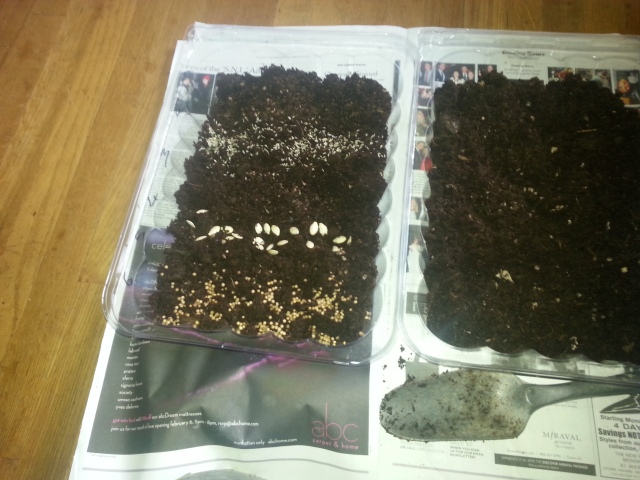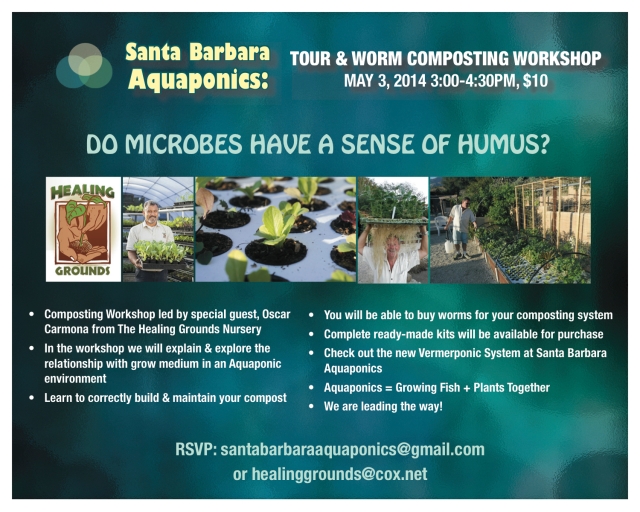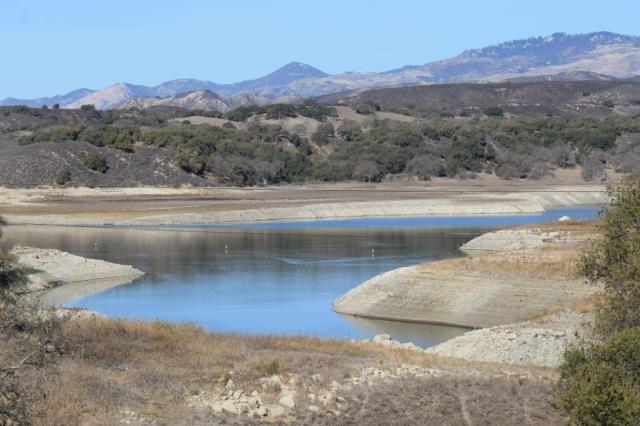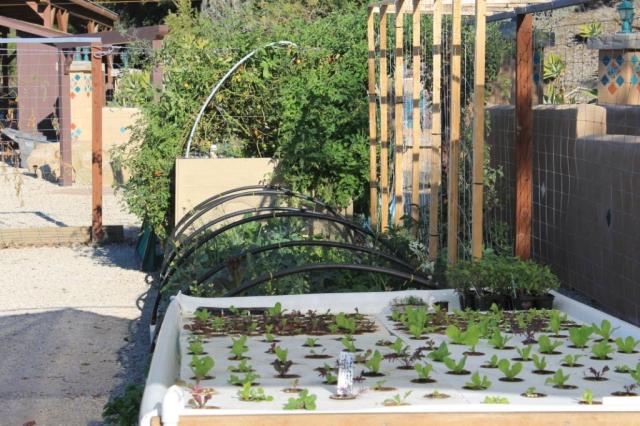If he could, he would probably swim through the air in search of those yummy food nuggets.
Category: Blog
These seeds were put in around March. I also use an old cake container. I fill the containers about two inches deep with my Aquaponic basket mix. The mix is very loamy, so as to let the air circulate through the mix keeping it aerobic. I also wet the mix, but not saturate, just a feeling of dampness. The general rule is put the seed in as deep as physical size. I will generally take a hand full of my mix and lightly sprinkle all the seeds putting a little more on the bigger ones and a little less on the smaller ones. This creates the depth continuity. Lastly, put a lid on either tight on or with an air gap if theres high humidity. After a few days you will start to see some of the quicker germinating seeds show their heads. The mix can also start to dry as the seedlings start to emerge. I take a spray bottle and ever so lightly give them a quick water spray or depending on your judgement and experience spray a light compost tea. When the seedlings are up and running I put them out doors in the nursery raft area ready to go into the main system. Cold nights can make germination somewhat unpredictable, however indoors with controlled temps can sometimes yield more consistent results. Most of the crop that is in the system at the moment has been germinated much the same way. In fact it is really surprising the amount of seedlings that appear making a lot of transplants to an Aquaponic basket. The good news, you know how many plants you are dealing with so you can more accurately project the yield.
Santa Barbara Aquaponics is a progressive venture into the farming of the future. We encourage you to take an interest. Our lives may one day depend on it! Thank you!
Off season produce anyone? Try Aquaponics!

Like the rest of the country, Santa Barbara has seen some below freezing temperatures lately. While this freak weather for a place famous for its absolutely stunning weather puts us in a chill while we’re working, our produce just keeps humming along. Air temperature the other morning at 7:30- 35 F, water temperature 60 F. Thank you solar hot water!
Here at Santa Barbara Aquaponics, we advocate for sustainable solutions to societies problems with food. We will readily admit that we’ve got a long way to go but one of the great parts about what we’re doing is working with solutions that try to reduce our impact on, well, everything. Since early this spring, we’ve had a solar hot water system installed that has done a great job of keeping our water temperature up so the metabolism of our catfish stays high, so they want to eat a lot, so they poop a lot, so a lot of nutrients are generated, so…. you get the picture. We could have installed electric heaters and gotten the temp up higher. Natural gas heaters weren’t really an option with no gas line nearby but we could have also looked into propane but we really don’t need it. The solar does a great job in keeping our water temperatures above ambient most of the time, and since channel catfish can survive low temperatures, unlike Tilapia, we’re ok either way. But since we don’t want water temperatures to be low, we’re stoked to have a significant bump up in water temperatures, thanks to our trusty solar hot water heater.
The tomato plants look great and are so far, no worse for wear from multiple nights of below freezing temps. We may be singing a different tune later this winter but for now, we will be happy that our hot water comes from the sun!
Randy Turner
I’ll take this Turkey Day to give thanks to another critter deserving of praise, the Channel Catfish. The engine to our aquaponics system, we love how they quietly go about their business, eating the food we give them and passing on their waste to our plants. They are a pretty flexible species, able to withstand water temperatures that would make a Tilapia go ‘shiny side up’ and are fairly non aggressive.
Besides having our catfish in the IBC tote, we been experimenting with catfish also in our deep water culture (DWC) trough. While only 1′ deep, the catfish are doing great and don’t mess with the plant roots at all. It does get a little crowded in there but the previous ‘rule’ of separating fish and veggies can be broken. Now for those with Tilapia, that wouldn’t work because they would destroy the plant roots. Score one more for catfish!
Our next system design might very well take advantage of this experiment and be a single, deeper DWC trough. This approach would simplify construction, nearly eliminate plumbing, cut costs, and reduce potential points of failure. What’s not to be thankful for about all that? Aquaponics will evolve and we hope become something easier, more foolproof, more sustainable, and more productive.
So on behalf of my future self, I want to thank the venerable catfish as well as this current generation of aquaponics innovators. Lets strive to accomplish more with what we have and never stop learning how to do it better.
Randy Turner
There are many ways to ‘do’ aquaponics. In fact, the concept itself is so broad as to cover everything from rice farmers who have fish in their paddies to high tech climate controlled greenhouse aquaponics. The core concept of polyculture and pairing complementary species like fish and plants gives us something with lots of possibilities. While it would be great to claim that the Santa Barbara Aquaponics model is the best, the best system for you needs to consider your wants, your location, and your level of involvement. Luckily, aquaponics is flexible enough to meet most people’s wants, location, and involvement.
 Broccoli, watercress, and kale thriving at Santa Barbara Aquaponics
Broccoli, watercress, and kale thriving at Santa Barbara Aquaponics
Do you want a system big enough to feed friends and family or have a particular vegetable in mind? Easy enough.
Would you rather have a small system to grow herbs that fits on your patio? No problem.
Do you need a system that is automated for those long weekends away with the family? That’s possible too.
So understand, before you commit to an aquaponics system, think about what you want to grow, what space and sun conditions are available, and what level of involvement you want. Your answers are crucial to helping you or others plan and build your system the way that works for you.
System Size- The bigger the better? For some, that is yes. In fact, the economy of scale means making it twice as big sometimes only costs a little more. Balancing the system size with your needs is important. Knowing what types of plants you want to grow helps you plan for how much space you’ll need.
System Location- The concept of Right Plant, Right Place common to gardening holds true in aquaponics. If your aquaponics system will get lots of shade or is especially windy, you need to take this into account as well, just like in soil. If you’re on a moderate slope, there are even some fairly easy steps to nearly avoid grading.
System Involvement- How much do you want to tinker with your system? Do you want to feed them three or four times a day and keep it immaculate? Will you only have time on the weekends? These are important considerations and will affect how much automation and maintenance you should plan on.
Whatever you choose, know that Santa Barbara Aquaponics is there to help you answer these questions and design a system for you that meets your culinary needs, works within your space, and fits your schedule. What can we do for you?
By Randy Turner
Santa Barbara Aquaponics will be hosting its first ever Public Tour on Saturday September 21st from 3-6 pm. RSVP’s requested.
Kevin and Randy will lead a tour of Santa Barbara’s first aquaponics demonstration facility, guide participants through the basics of aquaponics and help participants understand how aquaponics can be a valuable addition to backyard vegetable gardens, koi ponds, permaculture projects, or vacant spaces.
Light refreshments provided. Directions for those who have RSVP’d will arrive via email.
Thanks for your interest, however we are at capacity for the tour this Saturday. If you are interested in future tours, please leave your name and email below, along with any comments you have.
Best,
Kevin and Randy
Kevin explains aquaponics, what Santa Barbara Aquaponics has been doing, and where we hope aquaponics can go.










